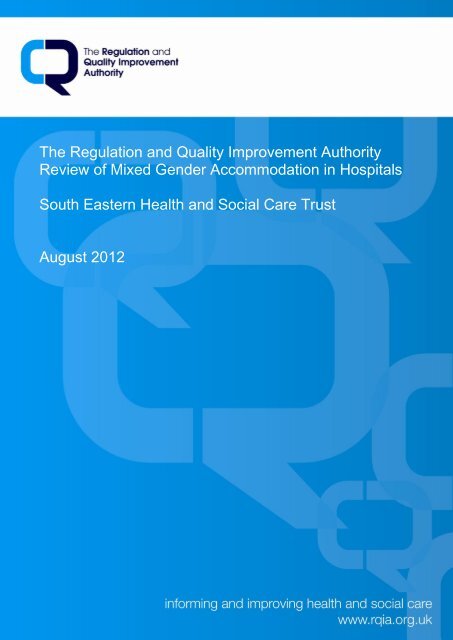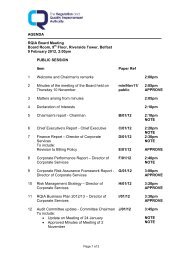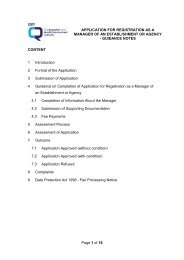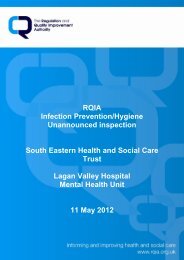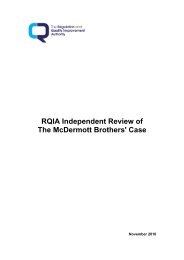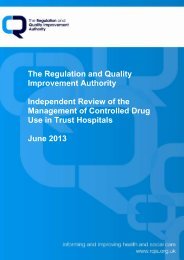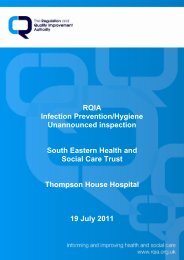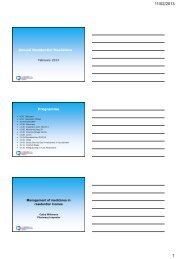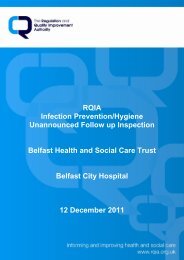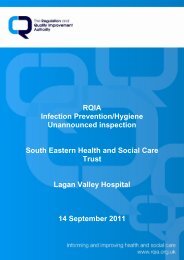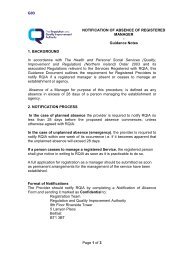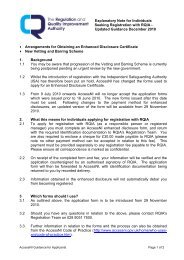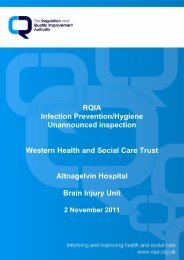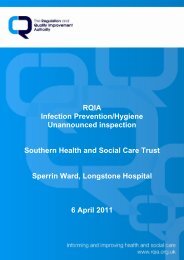Review of Mixed Gender Accommodation in Hospitals, South ...
Review of Mixed Gender Accommodation in Hospitals, South ...
Review of Mixed Gender Accommodation in Hospitals, South ...
You also want an ePaper? Increase the reach of your titles
YUMPU automatically turns print PDFs into web optimized ePapers that Google loves.
The Regulation and Quality Improvement Authority<br />
<strong>Review</strong> <strong>of</strong> <strong>Mixed</strong> <strong>Gender</strong> <strong>Accommodation</strong> <strong>in</strong> <strong>Hospitals</strong><br />
<strong>South</strong> Eastern Health and Social Care Trust<br />
August 2012
Contents<br />
Section 1 Introduction<br />
1.1 The Regulation and Quality Improvement Authority 1<br />
1.2 Context for the <strong>Review</strong> 1<br />
1.3 Terms <strong>of</strong> Reference 3<br />
1.4 The <strong>Review</strong> Team 4<br />
1.5 Methodology 4<br />
Section 2<br />
F<strong>in</strong>d<strong>in</strong>gs <strong>of</strong> the <strong>Review</strong> Team<br />
2.1 F<strong>in</strong>d<strong>in</strong>gs <strong>of</strong> the Inspection <strong>of</strong> Wards <strong>in</strong> Ulster Hospital, Downe Hospital<br />
and Lagan Valley Hospital 7<br />
2.2 Overall Comments on the Inspections <strong>of</strong> the Wards 10<br />
2.3 Discussions with Cl<strong>in</strong>ical Staff 11<br />
2.4 What Arrangements are <strong>in</strong> Place to Manage <strong>Mixed</strong> <strong>Gender</strong> Care <strong>in</strong> the<br />
SEHSCT? 15<br />
Section 3<br />
Conclusions and Recommendation<br />
3.1 Conclusions 18<br />
3.2 Recommendations 19
Introduction<br />
1.1 The Regulation and Quality Improvement Authority (RQIA)<br />
The Regulation and Quality Improvement Authority (RQIA) was established <strong>in</strong> 2005<br />
under The Health and Personal Social Services (Quality, Improvement and<br />
Regulation) (Northern Ireland) Order 2003.<br />
RQIA is the <strong>in</strong>dependent body responsible for monitor<strong>in</strong>g and <strong>in</strong>spect<strong>in</strong>g the quality<br />
and availability <strong>of</strong> health and social care services <strong>in</strong> Northern Ireland, and<br />
encourag<strong>in</strong>g improvements <strong>in</strong> the quality <strong>of</strong> those services.<br />
RQIA has a key role <strong>in</strong> assur<strong>in</strong>g the quality <strong>of</strong> services provided by the health and<br />
social care board, trusts and agencies. This activity is undertaken through specific<br />
reviews <strong>of</strong> cl<strong>in</strong>ical and social care governance arrangements with<strong>in</strong> these bodies, as<br />
set out <strong>in</strong> RQIA's Three Year <strong>Review</strong> Programme 2009-12.<br />
RQIA's Corporate Strategy 2009-12 identifies four core activities which are <strong>in</strong>tegral to<br />
how RQIA undertakes all aspects <strong>of</strong> its work. These are: improv<strong>in</strong>g care; <strong>in</strong>form<strong>in</strong>g<br />
the population; safeguard<strong>in</strong>g rights; and <strong>in</strong>fluenc<strong>in</strong>g policy.<br />
This review has been undertaken under article 35(1) (b) <strong>of</strong> The Health and Personal<br />
Social Services (Quality, Improvement and Regulation) (Northern Ireland) Order<br />
2003.<br />
1.2 Context for the <strong>Review</strong><br />
All health and social care organisations operate with<strong>in</strong> the pr<strong>in</strong>ciples which underp<strong>in</strong><br />
the Quality Standards for Health and Social Care 1 (DHSSPS). These pr<strong>in</strong>ciples are<br />
outl<strong>in</strong>ed <strong>in</strong> the standards and further re<strong>in</strong>forced <strong>in</strong> the Patient and Client Experience<br />
Standards 2 under the head<strong>in</strong>g <strong>of</strong> respect, attitude, behaviour, communication and<br />
dignity.<br />
The Department <strong>of</strong> Health (DoH) (England) def<strong>in</strong>es s<strong>in</strong>gle sex accommodation as<br />
separate sleep<strong>in</strong>g areas for men and women, segregated bathroom and toilet<br />
facilities for men and women and, <strong>in</strong> those trusts provid<strong>in</strong>g mental health services,<br />
safe facilities for the mentally ill. S<strong>in</strong>gle sex accommodation can be provided <strong>in</strong><br />
s<strong>in</strong>gle sex wards or comb<strong>in</strong>ations <strong>of</strong> s<strong>in</strong>gle rooms and s<strong>in</strong>gle sex bays <strong>in</strong> mixed<br />
wards<br />
<strong>Mixed</strong> sex accommodation 3 is where men and women have to share sleep<strong>in</strong>g<br />
accommodation, toilets or wash<strong>in</strong>g facilities.<br />
The DoH highlight that men and women should have access to separate toilet and<br />
wash<strong>in</strong>g facilities, ideally with<strong>in</strong> or next to their ward, bay or room. Patients should<br />
1 Quality Standards for Health and Social Care (DHSSPS)<br />
2 Patient and Client Experience Standards: Improv<strong>in</strong>g the Patient Client Experience (DHSSPS)<br />
3 <strong>Mixed</strong> Sex <strong>Accommodation</strong> <strong>in</strong> hospitals is where patients <strong>of</strong> the opposite sex have to share sleep<strong>in</strong>g<br />
accommodation, toilets and wash<strong>in</strong>g facilities (DoH)<br />
1
not need to go through sleep<strong>in</strong>g areas or toilet and wash<strong>in</strong>g facilities used by the<br />
opposite sex to access their own.<br />
This applies to all areas <strong>of</strong> hospitals, <strong>in</strong>clud<strong>in</strong>g admissions wards and critical care<br />
areas; such as <strong>in</strong>tensive care units and high dependency units. In exceptional<br />
circumstances, it may be necessary to accommodate men and women together,<br />
where the need for highly specialised or urgent care takes cl<strong>in</strong>ical priority. In these<br />
circumstances, staff must act <strong>in</strong> the <strong>in</strong>terests <strong>of</strong> all the patients <strong>in</strong>volved, and patients<br />
should be moved to same sex accommodation as soon as possible. Until this<br />
happens, staff should take practical steps to protect patients‟ privacy and dignity, for<br />
example by provid<strong>in</strong>g clear <strong>in</strong>formation and mak<strong>in</strong>g sure that private conversations<br />
cannot be overheard.<br />
The NHS Constitution states that all patients should feel that their privacy and dignity<br />
are respected dur<strong>in</strong>g their time <strong>in</strong> hospital. Same sex accommodation is “a visible<br />
affirmation” <strong>of</strong> this commitment.<br />
Privacy 4 is an important <strong>in</strong>fluence on patients‟ overall perception <strong>of</strong> the quality <strong>of</strong><br />
care they receive. The issues <strong>in</strong>volved go beyond the physical environment <strong>in</strong>to bed<br />
management and management <strong>of</strong> patient flow, organisation <strong>of</strong> admissions and<br />
elective treatment, and the expectation <strong>of</strong> all staff that patients will have their privacy<br />
and dignity protected.<br />
<strong>Mixed</strong> gender ward accommodation is a recognised concern for some patients for<br />
personal and cultural reasons.<br />
The Race Relations Amendment Act (2000)8, the Human Rights Act (1998) and<br />
pr<strong>in</strong>ciples from the United Nations and the recent Health Select Committee on<br />
Human Rights have all raised the need to consider equal and fair treatment as a<br />
matter <strong>of</strong> dignity and human rights.<br />
This review has been undertaken as a basel<strong>in</strong>e assessment to exam<strong>in</strong>e the<br />
processes put <strong>in</strong> place by HSC trusts <strong>in</strong> relation to the management <strong>of</strong> care <strong>in</strong> mixed<br />
gender accommodation. Currently there are no equivalent standards <strong>in</strong> Northern<br />
Ireland to those <strong>in</strong> England. The DoH has clearly articulated <strong>in</strong> its policy, zero<br />
tolerance <strong>in</strong> respect <strong>of</strong> care <strong>in</strong> mixed gender accommodation.<br />
In Northern Ireland the DHSSPS has a specific policy aim to provide s<strong>in</strong>gle rooms for<br />
all patients <strong>in</strong> new acute hospitals and major hospital refurbishments, which will<br />
facilitate greater privacy and dignity for patients <strong>in</strong> those facilities.<br />
A letter 5 was circulated to the Health and Social Care Board (HSC Board), Public<br />
Health Agency (PHA) and Health and Social Care trusts (HSCT) by the Chief<br />
Nurs<strong>in</strong>g Officer (CNO) entitled „Privacy and dignity - mixed gender accommodation <strong>in</strong><br />
hospitals: 21 May 2009. This letter stated that … “<strong>Mixed</strong> gender accommodation<br />
has been identified by patients and relatives/carers as hav<strong>in</strong>g a significant impact on<br />
4 Privacy and Dignity report (1997). Privacy and Dignity-a report by the Chief Nurs<strong>in</strong>g Officer <strong>in</strong>to<br />
mixed sex accommodation <strong>in</strong> hospitals. (DoH)<br />
5 Privacy and Dignity-<strong>Mixed</strong> sex <strong>in</strong>patient accommodation <strong>in</strong> hospitals, from the Chief Nurs<strong>in</strong>g Officer,<br />
Pr<strong>of</strong>essor Mart<strong>in</strong> Bradley, 21 May 2009 (DHSSPS)<br />
2
ma<strong>in</strong>ta<strong>in</strong><strong>in</strong>g privacy and dignity whilst <strong>in</strong> hospital. There should be a presumption<br />
therefore that men and women will not be required to sleep <strong>in</strong> the same area, nor<br />
use mixed bath<strong>in</strong>g and WC facilities. Patients wish to be protected from unwanted<br />
exposure, <strong>in</strong>clud<strong>in</strong>g casual overlook<strong>in</strong>g and overhear<strong>in</strong>g.”<br />
No further guidance or policy statements have been issued by the DHSSPS <strong>in</strong><br />
respect <strong>of</strong> the issue.<br />
As a result, trusts have been required to consider the issue us<strong>in</strong>g the patient<br />
experience standards and have also had to develop local policies and report<strong>in</strong>g<br />
mechanisms to record occurrences when they happen. Dur<strong>in</strong>g the course <strong>of</strong> the<br />
review it was highlighted by the PHA that they had issued further guidance to all<br />
trusts <strong>in</strong> respect <strong>of</strong> mixed gender accommodation, however all trusts reported <strong>in</strong><br />
advance <strong>of</strong> the review that this guidance had not been received.<br />
1.3 Terms <strong>of</strong> Reference<br />
To pr<strong>of</strong>ile the occurrences <strong>of</strong> the use <strong>of</strong> mixed gender accommodation <strong>in</strong><br />
adult acute, general, hospital sett<strong>in</strong>gs <strong>in</strong> Northern Ireland and the<br />
management <strong>of</strong> risk associated with care <strong>in</strong> such circumstances.<br />
To look at the volume and nature <strong>of</strong> compla<strong>in</strong>ts made over a three year<br />
period relat<strong>in</strong>g to the care <strong>of</strong> <strong>in</strong>dividuals <strong>in</strong> mixed gender acute adult ward<br />
accommodation.<br />
To determ<strong>in</strong>e if the trusts have a policy <strong>in</strong> respect <strong>of</strong> mixed gender<br />
accommodation and assess any human rights implications for the provision<br />
<strong>of</strong> services.<br />
To assess the implementation and impact <strong>of</strong> the Patient and Client<br />
Experience Standards (DHSSPS 2008) <strong>in</strong> relation to mixed gender<br />
accommodation, and other relevant DHSSPS policy and guidance.<br />
To report on the f<strong>in</strong>d<strong>in</strong>gs and make recommendations on how the service<br />
user experience for mixed gender accommodation can be improved.<br />
3
1.4 The <strong>Review</strong> Team<br />
RQIA established an <strong>in</strong>dependent review team, to carry out this review. The<br />
membership is as follows:<br />
Phelim Qu<strong>in</strong>n, - Director <strong>of</strong> Regulation and Nurs<strong>in</strong>g, RQIA<br />
Hilary Brownlee - Independent <strong>Review</strong>er<br />
Margaret Keat<strong>in</strong>g - RQIA Inspector<br />
Sheelagh O‟Connor - RQIA Inspector<br />
Supported by:<br />
Mary McClean<br />
Patricia Corrigan<br />
- Project Manager, RQIA<br />
- Project Adm<strong>in</strong>istrator<br />
1.5 Methodology<br />
The review process had four key phases:<br />
1. Completion <strong>of</strong> a self- assessment questionnaire relat<strong>in</strong>g to the structures,<br />
policies and processes <strong>in</strong> place to ensure that privacy, dignity and respect<br />
are afforded to all patients <strong>in</strong> mixed gender accommodation <strong>in</strong> adult acute,<br />
general hospital sett<strong>in</strong>gs. This assessment was made aga<strong>in</strong>st the Patient<br />
and Client Experience standards and actions as listed <strong>in</strong> „Privacy and<br />
dignity - mixed sex accommodation <strong>in</strong> hospitals (CNO 5/2009). The criteria<br />
used <strong>in</strong> this self- assessment were developed by RQIA. A pr<strong>of</strong>ile <strong>of</strong><br />
occurrences <strong>of</strong> mixed gender accommodation was <strong>in</strong>cluded at this stage.<br />
2. Inspection by the review team <strong>of</strong> randomly selected hospital wards, us<strong>in</strong>g a<br />
specially adapted data collection tool to measure the extent to which the<br />
trust actively supports good practice pr<strong>in</strong>ciples <strong>of</strong> privacy, dignity and<br />
respect for all patients who are cared for <strong>in</strong> mixed gender accommodation.<br />
3. A discussion session with members <strong>of</strong> trust‟s senior management team to<br />
assess the commitment by the <strong>South</strong> Eastern Health Social Care Trust<br />
(SEHSCT) to m<strong>in</strong>imis<strong>in</strong>g the use <strong>of</strong> mixed gender accommodation. This<br />
discussion enabled the review team to make an assessment <strong>of</strong> the relevant<br />
governance arrangements with<strong>in</strong> the trust <strong>in</strong> respect <strong>of</strong> the management <strong>of</strong><br />
care <strong>in</strong> mixed gender accommodation.<br />
4. Report<strong>in</strong>g and publication <strong>of</strong> the f<strong>in</strong>d<strong>in</strong>gs <strong>of</strong> the review.<br />
Def<strong>in</strong>itions:<br />
For the purpose <strong>of</strong> this review RQIA uses the follow<strong>in</strong>g def<strong>in</strong>itions:<br />
<strong>Mixed</strong> <strong>Gender</strong> accommodation: is where patients <strong>of</strong> the opposite gender have to<br />
share sleep<strong>in</strong>g accommodation, toilets or wash<strong>in</strong>g facilities.<br />
4
Room: a s<strong>in</strong>gle or multi-bedded sleep<strong>in</strong>g area, which is fully enclosed with solid<br />
walls and door.<br />
Bay: a s<strong>in</strong>gle or multi-bedded sleep<strong>in</strong>g area which is fully enclosed on three sides<br />
with solid walls. The fourth side may be open or partially enclosed. The use <strong>of</strong><br />
curta<strong>in</strong>s alone between bays is not acceptable, as they <strong>of</strong>fer little visual privacy and<br />
no auditory privacy.<br />
Adjacent: where bath/shower rooms and toilets are not provided as en-suite<br />
facilities, these should be located as close to the bay or room as possible and clearly<br />
designated as either male or female facilities. Patients should not have to walk<br />
through areas occupied by the opposite gender to reach the facilities.<br />
This data collection tool was developed by RQIA from the follow<strong>in</strong>g audit tools:<br />
„Privacy and Dignity: The elim<strong>in</strong>ation <strong>of</strong> mixed sex accommodation Good<br />
Practice Guidance and Self-Assessment Checklist‟ (NHS Institute for<br />
Innovation and Improvement).<br />
Privacy and Dignity Audit Tool (2009) NHS <strong>South</strong> Tyneside NHS<br />
Foundation Trust.<br />
The <strong>in</strong>spections were, to some extent unannounced, as hospital personnel were not<br />
given prior knowledge <strong>of</strong> which wards would be visited by reviewers. The <strong>in</strong>spection<br />
<strong>in</strong>volved observation <strong>of</strong> practice, talk<strong>in</strong>g to staff and patients and/or, review<strong>in</strong>g<br />
documentary evidence.<br />
The <strong>South</strong> Eastern Health and Social Care Trust (SEHSCT)<br />
Over the past year, the SEHSCT reported that the number <strong>of</strong> acute emergency<br />
admissions has cont<strong>in</strong>ued to <strong>in</strong>crease. As shown <strong>in</strong> table 1, at the Ulster Hospital,<br />
the number <strong>of</strong> emergency admissions <strong>in</strong>creased from 17,806 <strong>in</strong> 2009-10 to 18,592 <strong>in</strong><br />
2010-11.<br />
Table 1: Number <strong>of</strong> Hospital Admissions with<strong>in</strong> the SEHSCT<br />
Hospital 2009/10 2010/11 % change<br />
Downe Hospital 3,373 2,888 (-)14.3<br />
Lagan Valley<br />
3,752 3,766 (+) 0.37<br />
Hospital<br />
Ulster Hospital 1,7806 18,592 (+) 4.4<br />
Bangor 131 67 (-) 2.3<br />
Newtownards 86 46 (-) 46.5<br />
Total 25,148 25,359 (+)0.83<br />
This reported <strong>in</strong>crease <strong>in</strong> emergency admissions <strong>in</strong> the Ulster Hospital, Dundonald<br />
(UHD) and Lagan Valley Hospital (LVH) has led to decisions be<strong>in</strong>g made on a daily<br />
basis <strong>in</strong> these hospitals where cl<strong>in</strong>ical/safety, observation or bed pressures must<br />
take precedence over complete gender segregation.<br />
5
As a result <strong>of</strong> <strong>in</strong>creas<strong>in</strong>g pressure <strong>in</strong> respect <strong>of</strong> emergency admissions, the review<br />
team noted the impact <strong>of</strong> a range <strong>of</strong> performance <strong>in</strong>itiatives on issues <strong>of</strong> privacy and<br />
dignity and other aspects <strong>of</strong> patient experience. These <strong>in</strong>cluded the proliferation <strong>of</strong><br />
medical assessment units with high patient turnover, developed to assist more<br />
effective throughput <strong>of</strong> patients. This impact was evident <strong>in</strong> the SEHSCT. These<br />
<strong>in</strong>itiatives have a heavy emphasis on patient flow, but appear not to take account <strong>of</strong><br />
pressure on staff to accept admissions <strong>in</strong>to mixed gender bays.<br />
It was reported that senior staff work hard to ensure that where patients are placed <strong>in</strong><br />
mixed gender accommodation this arrangement is reviewed on a daily basis, and all<br />
efforts are made to ensure that patients are transferred <strong>in</strong>to s<strong>in</strong>gle sex bays at the<br />
earliest opportunity.<br />
6
Section 2: F<strong>in</strong>d<strong>in</strong>gs <strong>of</strong> the <strong>Review</strong> Team<br />
2.1 F<strong>in</strong>d<strong>in</strong>gs <strong>of</strong> the Inspection <strong>of</strong> Wards <strong>in</strong> Ulster Hospital, Downe Hospital<br />
and Lagan Valley Hospital<br />
The review team carried out <strong>in</strong>spections <strong>of</strong> five randomly selected hospital wards.<br />
These were <strong>in</strong> the Ulster Hospital, Downe Hospital and Lagan Valley Hospital, us<strong>in</strong>g<br />
a specially adapted data collection tool to measure the physical ward environment<br />
and <strong>in</strong>dividual ward practices aga<strong>in</strong>st good practice pr<strong>in</strong>ciples <strong>of</strong> privacy and dignity.<br />
It should be noted that when a medical assessment unit (MAU) operated with<strong>in</strong> a<br />
hospital, this was given priority for the <strong>in</strong>spection, as the PHA had <strong>in</strong>dicated that this<br />
was the cl<strong>in</strong>ical area most prone to mixed gender accommodation occurrences.<br />
The table below shows the results <strong>of</strong> the f<strong>in</strong>d<strong>in</strong>gs <strong>of</strong> the <strong>in</strong>spection <strong>of</strong> the follow<strong>in</strong>g<br />
wards visited <strong>in</strong> hospitals with<strong>in</strong> the SEHSCT area:<br />
Downe Hospital (DH) Ward 1<br />
Lagan Valley Hospital (LVH)<br />
Medical Assessment Unit (MAU)<br />
Ward 1B<br />
Ulster Hospital, Dundonald (UHD)<br />
Ward 15 Medical Assessment Unit (MAU)<br />
Ward 18 Orthopaedics<br />
Standard:<br />
The Physical Environment Actively Supports Patients’ Privacy<br />
and Dignity.<br />
Table 2: F<strong>in</strong>d<strong>in</strong>gs from Inspection <strong>of</strong> Wards Visited <strong>in</strong> SEHSCT<br />
Downe<br />
LVH<br />
MAU<br />
LVH<br />
Ward<br />
1B<br />
UHD<br />
Ward 15<br />
(MAU)<br />
UHD<br />
Ward<br />
18<br />
Criteria (at the time <strong>of</strong> review)<br />
1. Patients are cared for <strong>in</strong><br />
s<strong>in</strong>gle gender bays Yes Yes Yes No No<br />
Comment:<br />
S<strong>in</strong>gle gender bays have always be used <strong>in</strong> the Downe Hospital s<strong>in</strong>ce it opened <strong>in</strong><br />
2009.<br />
In Ward 15, UHD there were two male patients and two female patients <strong>in</strong> one<br />
bay. In another bay there were five female patients and one male patient. In<br />
Ward 18 there was one male patient <strong>in</strong> a bay with three female patients.<br />
2. Partitions separat<strong>in</strong>g men<br />
and women are robust<br />
enough to prevent casual<br />
overlook<strong>in</strong>g and overhear<strong>in</strong>g<br />
Yes No Yes No Yes<br />
Comment<br />
In LVH the male and female bays overlooked each other.<br />
3. Staff knock/request<br />
permission before enter<strong>in</strong>g a<br />
Not observed<br />
7
ed area if curta<strong>in</strong>s are<br />
closed<br />
Comment:<br />
4. The ward is managed with<br />
male and female sections,<br />
male and female toilets and<br />
wash<strong>in</strong>g facilities (other than<br />
assisted or accessible<br />
facilities)<br />
Yes Yes Yes Yes No<br />
Comment:<br />
The toilet facilities <strong>in</strong> Wards 15 and 18 UHD are limited, <strong>in</strong> Ward 18 there are two<br />
unigender toilets (the signs above the doors <strong>in</strong>dicate that these are male toilets<br />
however they are used by both male and female patients). There are no nurse<br />
call systems <strong>in</strong> the one female toilet and a shower room <strong>in</strong> Ward 18.<br />
5. There is a private room or<br />
space available for use by<br />
patients to talk to staff or<br />
visitors<br />
Yes Yes Yes Yes Yes<br />
Comment:<br />
In LVH there are two rooms <strong>in</strong> each ward (one <strong>of</strong> which is an <strong>of</strong>fice or a staff<br />
room) that are available for visitors and patients to talk <strong>in</strong> private. In Wards 15<br />
and 18, UHD it was reported that a quiet room and the ward managers‟ <strong>of</strong>fices<br />
are <strong>of</strong>fered to patients for private meet<strong>in</strong>gs.<br />
6. Curta<strong>in</strong>s are long enough,<br />
thick enough, and full enough<br />
to be drawn fully around the<br />
bed area<br />
No Yes Yes No Yes<br />
Comment:<br />
In the Downe Hospital and <strong>in</strong> Ward 15 UHD, bed curta<strong>in</strong>s are short and could<br />
result <strong>in</strong> patients who occupy low beds to be observed.<br />
7. Where patients pass near<br />
to areas occupied by<br />
members <strong>of</strong> the opposite<br />
gender, adequate screen<strong>in</strong>g<br />
such as opaque glaz<strong>in</strong>g or<br />
bl<strong>in</strong>d/curta<strong>in</strong>s at w<strong>in</strong>dows and<br />
doors are used<br />
N/A No No Yes No<br />
Comment:<br />
<strong>Review</strong>ers noted that, <strong>in</strong> both wards <strong>in</strong> LVH and Ward 18 <strong>in</strong> UHD patients are<br />
required to pass by an open bay where patients <strong>of</strong> the opposite gender are cared<br />
for, to get to the shower/bathroom.<br />
8. All patients are<br />
adequately dressed and/or<br />
covered<br />
Yes Yes No Yes Yes<br />
Comment:<br />
A female patient <strong>in</strong> Ward 1B, LVH did not have adequate cover<strong>in</strong>g for her legs - a<br />
male visitor was present <strong>in</strong> the bay.<br />
9. Separate treatment<br />
area(s) are available, for care Yes No No No No<br />
8
to be provided away from the<br />
bedside<br />
Comment:<br />
In the Downe Hospital there are separate treatment and cl<strong>in</strong>ical rooms.<br />
All treatments are carried out at the bedside <strong>in</strong> both wards <strong>in</strong> LVH and <strong>in</strong> Ward 15<br />
UHD.<br />
10. Patients do not have<br />
more than two visitors at their<br />
bed area at any same time<br />
No visitors<br />
present<br />
Yes Yes Yes Yes<br />
Comment:<br />
A notice stat<strong>in</strong>g that the number <strong>of</strong> visitors per patient is restricted to two is posted<br />
at the entrance to all wards reviewed on this occasion.<br />
11. There is a<br />
vacant/engaged sign on all<br />
toilet doors<br />
Yes Yes Yes Yes Yes<br />
Comment:<br />
12. The shower rooms have<br />
a vacant/engaged sign Yes Yes Yes Yes No<br />
Comment:<br />
There is only one shower room <strong>in</strong> each <strong>of</strong> Wards 15 and 18, UHD. The shower<br />
room <strong>in</strong> Ward 18 UHD does not have a nurse call bell or vacant/engaged sign on<br />
the door.<br />
13. The bathroom has an<br />
engaged/vacant sign Yes Yes Yes Yes No<br />
Comment:<br />
There is no bathroom <strong>in</strong> Ward 18. UHD.<br />
14. Toilet and wash<strong>in</strong>g<br />
facilities are located with<strong>in</strong>, or<br />
close to the patient‟s room or<br />
bay.<br />
Yes No No No No<br />
Comment:<br />
In both wards <strong>in</strong> LVH, patients are required to pass by an open bay where<br />
patients <strong>of</strong> the opposite gender are cared for, to get to the shower/bathroom. In<br />
Wards 15 and 18, UHD the toilet and wash<strong>in</strong>g facilities are located on a side<br />
corridor – not visible from the nurses‟ station.<br />
15. Patients can reach toilets<br />
and wash<strong>in</strong>g facilities without<br />
the need to pass through<br />
areas occupied by members<br />
<strong>of</strong> the opposite gender<br />
Comment:<br />
As above<br />
16. Toilets and wash<strong>in</strong>g<br />
facilities are fitted with<br />
<strong>in</strong>ternal privacy curta<strong>in</strong>s<br />
where necessary<br />
Yes No Yes No No<br />
No No No Yes No<br />
Comment:<br />
Patients could be easily viewed by others when members <strong>of</strong> staff enter to give<br />
assistance.<br />
9
17. Toilets and bathroom<br />
doors are lockable from the<br />
<strong>in</strong>side, and are accessible to<br />
staff <strong>in</strong> the event <strong>of</strong> an<br />
emergency<br />
Comment:<br />
Yes Yes Yes Yes Yes<br />
18.<br />
Toilets/bathrooms/showers<br />
have nurse call systems that<br />
are accessible to patients<br />
and <strong>in</strong> good work<strong>in</strong>g order<br />
Yes Yes Yes Yes No<br />
Comment:<br />
There is no nurse call system <strong>in</strong> the shower room <strong>in</strong> Ward 18, UHD<br />
19. Where assisted<br />
bathrooms and/or showers<br />
are used by both men and<br />
women, appropriate facilities<br />
are provided to uphold the<br />
privacy and dignity <strong>of</strong> all<br />
patients who use them<br />
Yes No No No No<br />
Comment:<br />
In LVH, MAU and 1B there are no privacy curta<strong>in</strong>s <strong>in</strong> the bathrooms. In wards 15<br />
and 18, UHD the toilet doors open out <strong>in</strong>to the ward. In ward 15, UHD the<br />
assisted toilet is located opposite the reception area. A patient us<strong>in</strong>g this toilet<br />
would be clearly visible from the corridor when the door is open. At the time <strong>of</strong><br />
the review there was a queue <strong>of</strong> patients wait<strong>in</strong>g outside this toilet door.<br />
2.2 Overall Comments on the Inspections <strong>of</strong> the Wards<br />
Of the five areas visited there were two <strong>in</strong>stances <strong>in</strong> Ulster Hospital where mixed<br />
gender accommodation was be<strong>in</strong>g provided. Senior managers stated that they were<br />
do<strong>in</strong>g all with<strong>in</strong> their power to manage mixed gender occurrences; however the<br />
review team noted that occurrences were not always be<strong>in</strong>g managed with<strong>in</strong><br />
reasonable timescales; patients were not be<strong>in</strong>g transferred <strong>in</strong>to unigender<br />
accommodation with<strong>in</strong> a 24hour timeframe. Trust management asserted that this<br />
was as a result <strong>of</strong> <strong>in</strong>creas<strong>in</strong>g pressure on admission through their emergency<br />
department and restrictions <strong>in</strong> the older ward environments<br />
The cl<strong>in</strong>ical environment <strong>in</strong> Downe Hospital is <strong>of</strong> a high standard and is designed<br />
with consideration given to the provision <strong>of</strong> privacy and dignity for patients with<strong>in</strong><br />
s<strong>in</strong>gle gender accommodation. It was reported that there have been no occasions<br />
where patients have been accommodated <strong>in</strong> mixed gender accommodation <strong>in</strong> the<br />
Downe Hospital.<br />
Senior managers <strong>in</strong> the SEHSCT stated that they were do<strong>in</strong>g all with<strong>in</strong> their power to<br />
manage mixed gender occurrences; however the review team noted that the<br />
physical environment <strong>in</strong> Lagan Valley Hospital and Ulster Hospital is a major<br />
challenge to ensur<strong>in</strong>g privacy and dignity for patients when mixed gender<br />
10
accommodation is be<strong>in</strong>g provided. This was further re<strong>in</strong>forced by trust management<br />
<strong>in</strong> their discussion with the review team<br />
2.3 Discussions with Cl<strong>in</strong>ical Staff<br />
<strong>Review</strong>ers spoke with various grades <strong>of</strong> cl<strong>in</strong>ical nurs<strong>in</strong>g staff and posed the<br />
questions set out <strong>in</strong> the audit tool.<br />
The responses to these questions were as follows:<br />
Question 1<br />
Do you know <strong>of</strong> a trust policy for the care <strong>of</strong> patients <strong>in</strong> mixed gender<br />
accommodation? Where to access it? What is <strong>in</strong>cluded as a def<strong>in</strong>ition for mixed<br />
gender accommodation?<br />
<strong>Review</strong>ers‟ f<strong>in</strong>d<strong>in</strong>gs:<br />
All members <strong>of</strong> staff who spoke with reviewers were aware <strong>of</strong> the trust‟s policies,<br />
protocols and guidel<strong>in</strong>es on mixed gender accommodation. It was reported that<br />
these policies are accessible on the trust‟s <strong>in</strong>tranet site and <strong>in</strong> the policy folders that<br />
were <strong>in</strong> each <strong>of</strong> the wards. It was evident that the documents had been recently<br />
been reviewed and that there had been an <strong>in</strong>creased emphasis on the issues<br />
relat<strong>in</strong>g to mixed gender accommodation. The staff <strong>in</strong>terviewed were able to provide<br />
standard def<strong>in</strong>itions <strong>of</strong> mixed gender accommodation <strong>in</strong> l<strong>in</strong>e with the def<strong>in</strong>ition used<br />
by RQIA for this review.<br />
Question 2<br />
Does the trust/ward have a policy and procedure <strong>in</strong> respect <strong>of</strong> vulnerable adults?<br />
<strong>Review</strong>ers‟ f<strong>in</strong>d<strong>in</strong>gs:<br />
All members <strong>of</strong> staff provided correct def<strong>in</strong>itions <strong>of</strong> the term „vulnerable adult.‟ In all<br />
wards visited there is a policy <strong>in</strong> respect <strong>of</strong> vulnerable adults which has not been<br />
implemented. Not all members <strong>of</strong> staff have undertaken tra<strong>in</strong><strong>in</strong>g <strong>in</strong> respect <strong>of</strong><br />
vulnerable adults procedures and <strong>in</strong> a few <strong>in</strong>stances members <strong>of</strong> staff were not<br />
aware <strong>of</strong> the policy. There was a general lack <strong>of</strong> awareness <strong>of</strong> the vulnerability <strong>of</strong><br />
adults <strong>in</strong> hospital sett<strong>in</strong>gs. The review team were <strong>of</strong> the view that tra<strong>in</strong><strong>in</strong>g <strong>in</strong> the<br />
protection <strong>of</strong> vulnerable adults should be undertaken by all members <strong>of</strong> staff on an<br />
on-go<strong>in</strong>g mandatory basis and should be emphasised further <strong>in</strong> the <strong>in</strong>duction <strong>of</strong> all<br />
newly appo<strong>in</strong>ted cl<strong>in</strong>ical staff.<br />
Question 3<br />
What are the key considerations if a female or male patient were be<strong>in</strong>g admitted <strong>in</strong>to<br />
a mixed gender ward?<br />
11
<strong>Review</strong>ers‟ f<strong>in</strong>d<strong>in</strong>gs:<br />
All members <strong>of</strong> staff gave good accounts <strong>of</strong> the key considerations if a female or<br />
male patient was admitted <strong>in</strong>to a mixed gender bay <strong>in</strong> the ward. Members <strong>of</strong> staff <strong>in</strong><br />
the wards <strong>in</strong> Ulster Hospital spoke <strong>of</strong> the pressures from the accident and<br />
emergency (A&E) department to admit patients to mixed gender bays. They were<br />
very clear about the processes <strong>in</strong> place for members <strong>of</strong> staff <strong>in</strong> A&E to <strong>in</strong>form a<br />
patient before his/her admission to a mixed gender bay and this is recorded <strong>in</strong> the<br />
patient‟s case notes. It was evident that the patient flow department (department<br />
which manages bed availability) and the wards do not always work closely to ensure<br />
this is carried out.<br />
There were reported <strong>in</strong>stances where patients had arrived <strong>in</strong> wards without be<strong>in</strong>g<br />
made aware that they were be<strong>in</strong>g accommodated <strong>in</strong> mixed gender bays. It was<br />
evident that ward staff are aware <strong>of</strong> the need to reassure the patient and<br />
relatives/carers that the situation is be<strong>in</strong>g kept under review and when facilities are<br />
available the patient will be moved to s<strong>in</strong>gle gender accommodation. Members <strong>of</strong><br />
staff <strong>in</strong> Ulster Hospital spoke <strong>of</strong> measures that are taken to ensure that the use <strong>of</strong> the<br />
shower is staggered between male and female patients. All members <strong>of</strong> staff who<br />
spoke with reviewers demonstrated total awareness <strong>of</strong> the need to ensure that<br />
privacy, dignity and respect is ma<strong>in</strong>ta<strong>in</strong>ed and maximised for all patients <strong>in</strong> their care.<br />
Question 4<br />
What tra<strong>in</strong><strong>in</strong>g and/or <strong>in</strong>duction on mixed gender accommodation on how to manage<br />
care and treatment <strong>in</strong> relation to mixed gender wards have you received?<br />
<strong>Review</strong>ers‟ f<strong>in</strong>d<strong>in</strong>gs:<br />
No specific tra<strong>in</strong><strong>in</strong>g and/or <strong>in</strong>duction on manag<strong>in</strong>g care and treatment <strong>in</strong> relation to<br />
mixed gender wards has been <strong>of</strong>fered by the trust to the members <strong>of</strong> staff who spoke<br />
with reviewers. A few members <strong>of</strong> staff spoke about hav<strong>in</strong>g undertaken an <strong>in</strong>formal<br />
<strong>in</strong>duction programme which <strong>in</strong>cluded reference to the management <strong>of</strong> patients who<br />
are admitted <strong>in</strong>to mixed gender accommodation.<br />
Members <strong>of</strong> staff <strong>in</strong> Ward 18, MAU, Lagan Valley Hospital and the Downe Hospital<br />
spoke <strong>of</strong> teach<strong>in</strong>g sessions and policy updates that are arranged at ward level,<br />
usually dur<strong>in</strong>g staff meet<strong>in</strong>gs.<br />
Question 5<br />
How would you prevent or improve current patient placements with<strong>in</strong> the ward to<br />
ma<strong>in</strong>ta<strong>in</strong> segregation <strong>of</strong> men and women?<br />
<strong>Review</strong>ers‟ f<strong>in</strong>d<strong>in</strong>gs:<br />
Members <strong>of</strong> staff who spoke with reviewers referred to the mov<strong>in</strong>g <strong>of</strong> patients‟ beds<br />
with<strong>in</strong> wards to ma<strong>in</strong>ta<strong>in</strong> segregation <strong>of</strong> men and women. The implications for<br />
<strong>in</strong>fection prevention and control was seen by members <strong>of</strong> staff as a major issue <strong>in</strong><br />
relation to this action. Members <strong>of</strong> staff <strong>in</strong> Ward 18, Ulster Hospital reported that<br />
12
some elderly patients are assessed as high risk <strong>of</strong> fall<strong>in</strong>g and for that reason it is<br />
imperative that they are accommodated <strong>in</strong> beds close to the nurses‟ station <strong>in</strong> mixed<br />
gender accommodation.<br />
Staff also described the need to re-designate toilets for use by males or females<br />
depend<strong>in</strong>g on the location <strong>of</strong> patients with<strong>in</strong> the wards. It was notable that <strong>in</strong> the<br />
Ulster Hospital the number <strong>of</strong> toilets and shower rooms <strong>in</strong> some <strong>of</strong> the wards was<br />
extremely limited which resulted <strong>in</strong> these rooms be<strong>in</strong>g designated for use by both<br />
genders at all times.<br />
This is not an issue <strong>in</strong> the Downe Hospital.<br />
Question 6<br />
What issues/experiences have you encountered on the ward <strong>in</strong> relation to the<br />
care <strong>of</strong> patients <strong>in</strong> mixed gender accommodation?<br />
<strong>Review</strong>ers‟ f<strong>in</strong>d<strong>in</strong>gs:<br />
Members <strong>of</strong> staff reported that patients are <strong>of</strong>ten not happy with be<strong>in</strong>g<br />
accommodated <strong>in</strong> a mixed gender bay but are content to wait until alternative<br />
accommodation is provided. It was reported that where patients who are under 18<br />
years are admitted to mixed gender accommodation, this would be managed and<br />
recorded as a serious <strong>in</strong>cident.<br />
It was reported that on occasions, nurs<strong>in</strong>g staff are required to monitor some patients<br />
who would wander <strong>in</strong>to ward areas where opposite gender patients are be<strong>in</strong>g cared<br />
for. It was reported that sometimes patients are uncomfortable when they are<br />
required to share a mixed gender bay. Members <strong>of</strong> staff reported that there are<br />
<strong>in</strong>stances when mixed gender accommodation must be provided because <strong>of</strong> „bed<br />
pressures‟.<br />
In a few <strong>in</strong>stances it was reported that patients are so relieved that they have a bed<br />
<strong>in</strong> a ward that they do not object to mixed gender accommodation.<br />
Questions 7 and 9 relate to compla<strong>in</strong>ts procedures therefore the f<strong>in</strong>d<strong>in</strong>gs are<br />
grouped together.<br />
Question 7:<br />
What happens if patients express a concern about be<strong>in</strong>g placed <strong>in</strong> a mixed gender<br />
ward or bay?<br />
Question 9:<br />
What processes are <strong>in</strong> place at ward level for patients who wish to make a compla<strong>in</strong>t<br />
regard<strong>in</strong>g their care <strong>in</strong> mixed gender accommodation?<br />
13
<strong>Review</strong>ers‟ f<strong>in</strong>d<strong>in</strong>gs:<br />
When questioned about action taken when patients express a concern about be<strong>in</strong>g<br />
placed <strong>in</strong> a mixed gender ward or bay, members <strong>of</strong> staff <strong>in</strong> MAU <strong>in</strong> Lagan Valley<br />
Hospital reported that the ward manager and the bed manager work together to f<strong>in</strong>d<br />
s<strong>in</strong>gle gender accommodation for the patient. Members <strong>of</strong> staff were all very clear<br />
about the compla<strong>in</strong>ts procedure, should a patient wish to make a formal compla<strong>in</strong>t<br />
about mixed gender accommodation. A number <strong>of</strong> staff across the trust reported<br />
that an <strong>in</strong>cident form is completed when a patient expresses concern about be<strong>in</strong>g<br />
accommodated <strong>in</strong> a mixed gender bay. In most <strong>in</strong>stances staff seemed unaware that<br />
there had been any formal compla<strong>in</strong>ts made <strong>in</strong> respect <strong>of</strong> the issue.<br />
Question 8<br />
How are patient needs met <strong>in</strong> relation to ensur<strong>in</strong>g privacy, dignity and respect (<strong>in</strong><br />
relation to mixed gender accommodation)?<br />
<strong>Review</strong>ers‟ f<strong>in</strong>d<strong>in</strong>gs:<br />
All members <strong>of</strong> staff spoke <strong>of</strong> the need for patients to have access to segregated<br />
toilets and wash<strong>in</strong>g facilities which are clearly signposted. In some <strong>in</strong>stances <strong>in</strong><br />
Ulster Hospital the cl<strong>in</strong>ical environment does not make this easy to achieve. The<br />
need to ensure privacy through the use <strong>of</strong> additional screens or area dividers,<br />
avoidance <strong>of</strong> giv<strong>in</strong>g personal care at the bedside and us<strong>in</strong>g discretion when<br />
discuss<strong>in</strong>g sensitive <strong>in</strong>formation were all given as key privacy considerations. Close<br />
observation and ensur<strong>in</strong>g patients are wear<strong>in</strong>g appropriate cloth<strong>in</strong>g were also given<br />
as key actions to be taken to ensure privacy and dignity <strong>in</strong> any mixed gender<br />
accommodation.<br />
The review team noted that <strong>in</strong> newer facilitates <strong>in</strong> the Downe Hospital, these issues<br />
were dealt with through the design and location <strong>of</strong> toilets, cl<strong>in</strong>ical and treatment<br />
rooms.<br />
Question10 (a)<br />
What processes are <strong>in</strong> place for document<strong>in</strong>g <strong>in</strong>cidences <strong>in</strong> relation to the care <strong>of</strong><br />
patients <strong>in</strong> mixed gender accommodation at ward level?<br />
Question 10 (b)<br />
How is this <strong>in</strong>formation relayed to management with<strong>in</strong> the trust?<br />
Ward managers who spoke with reviewers reported that, at the time <strong>of</strong> the review,<br />
there was no trust process for record<strong>in</strong>g/report<strong>in</strong>g occurrences when patients are<br />
accommodated <strong>in</strong> mixed gender bays. It was noted that there were local record<strong>in</strong>g<br />
processes, which <strong>in</strong>cluded record<strong>in</strong>g <strong>in</strong> the patient‟s <strong>in</strong>dividual case notes and/or<br />
record<strong>in</strong>g <strong>in</strong> a book that is reta<strong>in</strong>ed <strong>in</strong> the ward manager‟s <strong>of</strong>fice and discussed<br />
dur<strong>in</strong>g safety brief<strong>in</strong>gs at the change <strong>of</strong> shift.<br />
14
2.4 What Arrangements are <strong>in</strong> Place to Manage <strong>Mixed</strong> <strong>Gender</strong> Care <strong>in</strong> the<br />
SEHSCT?<br />
The f<strong>in</strong>d<strong>in</strong>gs <strong>in</strong> this section <strong>of</strong> the report are based on discussions with members <strong>of</strong><br />
trust senior management team and the evidence submitted along with completed self<br />
assessment questionnaires <strong>of</strong> the structures, processes and tra<strong>in</strong><strong>in</strong>g <strong>in</strong> place to meet<br />
the Standards for improv<strong>in</strong>g the Patient and Client Experience (DHSSPS 2008) and<br />
the m<strong>in</strong>imisation <strong>of</strong> mixed gender accommodation.<br />
There is no specific regional policy for the care <strong>of</strong> <strong>in</strong>dividuals <strong>in</strong> mixed gender<br />
accommodation. The review team felt that <strong>in</strong> the absence <strong>of</strong> such a policy, no<br />
specific regional goals had been set on the m<strong>in</strong>imisation or elim<strong>in</strong>ation <strong>of</strong> mixed<br />
gender care. It was notable that the PHA had cited the dissem<strong>in</strong>ation <strong>of</strong> further<br />
guidel<strong>in</strong>es <strong>in</strong> respect <strong>of</strong> care <strong>in</strong> mixed gender accommodation <strong>in</strong> 2010, however, the<br />
trust reported that the guidance had not been received.<br />
In the absence <strong>of</strong> any regional policy or guidance <strong>in</strong> respect <strong>of</strong> mixed gender<br />
accommodation the SEHSCT developed a Policy for the Provision <strong>of</strong> Patient/Client<br />
S<strong>in</strong>gle Sex <strong>Accommodation</strong> which was reviewed <strong>in</strong> February 2011. The policy<br />
document has been made accessible to staff across the trust‟s <strong>in</strong>tranet site and <strong>in</strong><br />
hard copy. Staff <strong>in</strong>dicated to the review team that these documents are held <strong>in</strong><br />
cl<strong>in</strong>ical areas across the trust. These policy documents provide guidance for staff<br />
when s<strong>in</strong>gle gender bays cannot be provided and refers to actions to be taken with<strong>in</strong><br />
<strong>in</strong>dividual ward areas at that time. It was evident dur<strong>in</strong>g the review that the s<strong>in</strong>ce the<br />
implementation and dissem<strong>in</strong>ation <strong>of</strong> the trust policy, there has been a heightened<br />
awareness <strong>of</strong> the need to ensure privacy and dignity for patients <strong>in</strong> mixed gender<br />
accommodation and the need to m<strong>in</strong>imise their occurrence.<br />
The trust stated that mixed gender accommodation is only used when there are no<br />
available beds to facilitate s<strong>in</strong>gle gender accommodation which would result <strong>in</strong> a<br />
patient hav<strong>in</strong>g to rema<strong>in</strong> <strong>in</strong> the Emergency Departments as a delayed admission.<br />
This occurs more frequently <strong>in</strong> Medical Assessment Units. The review team noted<br />
that a number <strong>of</strong> the medical assessment units <strong>in</strong> the trust had been developed <strong>in</strong><br />
recent years to assist with performance <strong>in</strong> respect <strong>of</strong> wait<strong>in</strong>g and treatment times <strong>in</strong><br />
emergency departments.<br />
The trust reported that all patients have access to segregated toilets and wash<strong>in</strong>g<br />
facilities which are clearly signposted and that privacy is enhanced by additional<br />
privacy screens and area dividers. However as stated above it was notable that<br />
there were significant limitations <strong>in</strong> toilet and shower<strong>in</strong>g facilities <strong>in</strong> a number <strong>of</strong> the<br />
older wards <strong>in</strong> the Ulster Hospital. Staff and management <strong>in</strong> Ulster Hospital stated<br />
that these issues should be addressed for a number <strong>of</strong> wards dur<strong>in</strong>g the planned<br />
hospital renovation.<br />
It was reported by senior managers <strong>in</strong> the SEHSCT that there is a process whereby<br />
the Patient Flow Manager <strong>in</strong>forms the A&E department if a patient is to be placed <strong>in</strong><br />
mixed gender accommodation and consent is obta<strong>in</strong>ed from the patient by a member<br />
<strong>of</strong> nurs<strong>in</strong>g staff <strong>in</strong> A&E. They also stated that relatives were <strong>in</strong>formed prior to<br />
transfer to mixed gender bay. Discussions with ward staff would <strong>in</strong>dicate that this<br />
process is not always adhered to and that there are communication issues with A&E,<br />
15
patient flow and ward staff. It was reported that planned admissions would be<br />
<strong>in</strong>formed <strong>of</strong> the requirement to be placed <strong>in</strong> a mixed gender bay when they r<strong>in</strong>g to<br />
confirm bed availability. The trust states that this would be on very rare occasion,<br />
and patients may refuse and admission may be deferred until the next day/next<br />
available slot if appropriate.<br />
When patients are accommodated <strong>in</strong> mixed gender areas <strong>in</strong> SEHSCT, there is no<br />
trust wide process for report<strong>in</strong>g or audit<strong>in</strong>g these occurrences. The trust reports that<br />
a review <strong>of</strong> current practice <strong>in</strong> light <strong>of</strong> new policy requirements and an exam<strong>in</strong>ation <strong>of</strong><br />
the most effective system to ensure audit <strong>of</strong> <strong>in</strong>cidences and report<strong>in</strong>g through the<br />
appropriate governance structures is be<strong>in</strong>g considered.<br />
The trust reported that ward managers review current patient placements on a daily<br />
basis and, where possible, move patients with<strong>in</strong> the area to ma<strong>in</strong>ta<strong>in</strong> segregation <strong>of</strong><br />
men and women <strong>in</strong>to s<strong>in</strong>gle sex bays or s<strong>in</strong>gle room accommodation.<br />
The trust policy for the Provision <strong>of</strong> Patient/Client S<strong>in</strong>gle Sex <strong>Accommodation</strong><br />
emphasises that patients and relatives must be <strong>in</strong>formed prior to admission to a<br />
mixed gender area. It is reported that the trust admission leaflet makes reference to<br />
the possibility <strong>of</strong> be<strong>in</strong>g nursed <strong>in</strong> a mixed gender bay and outl<strong>in</strong>es the arrangements<br />
<strong>in</strong> place for manag<strong>in</strong>g this.<br />
At the time <strong>of</strong> the review the SEHSCT trust was <strong>in</strong> the process <strong>of</strong> undertak<strong>in</strong>g an<br />
<strong>in</strong>patient satisfaction survey relat<strong>in</strong>g to mixed gender wards <strong>in</strong> its acute care sett<strong>in</strong>gs.<br />
The questions posed <strong>in</strong> the survey relate to sleep<strong>in</strong>g accommodation <strong>in</strong> mixed<br />
gender wards and did not relate to bathroom or d<strong>in</strong><strong>in</strong>g facilities. A further question<br />
sought to f<strong>in</strong>d out if the option to move to another part <strong>of</strong> the ward had been <strong>of</strong>fered<br />
to the patient. This questionnaire was be<strong>in</strong>g rolled out across the trust and analysis<br />
<strong>of</strong> f<strong>in</strong>d<strong>in</strong>gs has not been completed at the time <strong>of</strong> the review.<br />
Information was provided to this review by the trust on all compla<strong>in</strong>ts from patients <strong>in</strong><br />
relation to the care provided <strong>in</strong> mixed gender accommodation s<strong>in</strong>ce 2007 (See table<br />
3). Dur<strong>in</strong>g this period a total <strong>of</strong> six compla<strong>in</strong>ts were recorded. The trust did not<br />
consider that any <strong>of</strong> these compla<strong>in</strong>ts required to be managed through the<br />
vulnerable adults process or escalated through the Serious Adverse Incidents (SAI)<br />
process to DHSSPS and the HSC Board.<br />
Table 3: Compla<strong>in</strong>ts Reported <strong>in</strong> <strong>Mixed</strong> <strong>Gender</strong> <strong>Accommodation</strong> S<strong>in</strong>ce 2007<br />
With<strong>in</strong> the SEHSCT<br />
Nature <strong>of</strong> Compla<strong>in</strong>t<br />
Date <strong>of</strong> Compla<strong>in</strong>t<br />
Concerns about mixed sex ward, issues 26/06/2007<br />
regard<strong>in</strong>g dignity<br />
Dissatisfaction about be<strong>in</strong>g a patient on a mixed 24/08/2007<br />
sex ward<br />
Felt mixed sex ward undignified 13/05/2008<br />
Unhappy to be placed <strong>in</strong> a mixed sex ward 05/06/2008<br />
Worried about mixed sex ward 19/05/2010<br />
Only woman on a male ward 27/09/2010<br />
16
The trust reported that the follow<strong>in</strong>g systems are <strong>in</strong> place to ensure that all<br />
development <strong>of</strong> future hospital facilities/wards plans are designed to provide s<strong>in</strong>gle<br />
gender accommodation across its hospitals:<br />
All new future builds or major reconstruction will have s<strong>in</strong>gle sex<br />
accommodation.<br />
Phase A <strong>of</strong> the Ulster Hospital development <strong>of</strong> the critical care complex has<br />
been designed to ensure that privacy and dignity <strong>of</strong> patients is ma<strong>in</strong>ta<strong>in</strong>ed.<br />
Phase B <strong>of</strong> the Ulster Hospital has fully implemented the DoH policy <strong>in</strong><br />
relation to the provision <strong>of</strong> s<strong>in</strong>gle gender rooms. The bus<strong>in</strong>ess case has<br />
been approved <strong>in</strong> 2010 and at present it is at the detailed design stage.<br />
The new generic ward block will comprise 288 beds with 100 per cent<br />
s<strong>in</strong>gle gender accommodation with full ensuite facilities.<br />
The new Downe build design considered the provision <strong>of</strong> s<strong>in</strong>gle gender<br />
accommodation and ma<strong>in</strong>tenance <strong>of</strong> privacy and dignity. There have been<br />
no occasions where patients have been nursed <strong>in</strong> mixed gender<br />
accommodation <strong>in</strong> the Downe Hospital.<br />
17
Section 3: Conclusions and Recommendations<br />
3.1 Conclusions<br />
The trust senior management team spoke <strong>of</strong> the challenges <strong>in</strong> achiev<strong>in</strong>g a reduction<br />
<strong>in</strong> occurrences <strong>of</strong> mixed gender accommodation <strong>in</strong> the current hospitals that are at<br />
least 25 years old with 100 per cent bed occupancy. The use <strong>of</strong> side wards for<br />
<strong>in</strong>fection control and the need to ensure that those patients who require close<br />
observation are accommodated close to nurses‟ stations were also highlighted as<br />
challenges <strong>in</strong> provid<strong>in</strong>g s<strong>in</strong>gle gender accommodation.<br />
As a result <strong>of</strong> the pressures cited, the review team felt that when <strong>in</strong>itiat<strong>in</strong>g<br />
improvement programmes related to improv<strong>in</strong>g performance targets or improv<strong>in</strong>g<br />
patient flow, the HSC Board and public health agency should consider the potential<br />
for any un<strong>in</strong>tended consequences on patient experience.<br />
The trust has developed a local policy for the Provision <strong>of</strong> Patient/Client S<strong>in</strong>gle Sex<br />
<strong>Accommodation</strong> <strong>in</strong> the absence <strong>of</strong> any regional policy or guidance <strong>in</strong> respect <strong>of</strong><br />
mixed gender accommodation. <strong>Review</strong>ers suggest that there is a need to prioritise<br />
the development <strong>of</strong> a def<strong>in</strong>itive regional policy statement detail<strong>in</strong>g the Department‟s<br />
position on the use <strong>of</strong> mixed gender accommodation and a commission<strong>in</strong>g<br />
specification that relates to the DHSSPS patient experience standards. It is vital that<br />
this standard takes account <strong>of</strong> the specific l<strong>in</strong>ks to the relevant articles <strong>of</strong> The Human<br />
Rights Act and that there is a harmonised approach to mixed gender care across all<br />
trusts.<br />
There is clear evidence that the <strong>in</strong>creased emphasis on mixed gender issues by<br />
senior managers across the SEHSCT and the implementation and dissem<strong>in</strong>ation <strong>of</strong><br />
policy has resulted <strong>in</strong> a greater awareness by members <strong>of</strong> staff <strong>in</strong> the cl<strong>in</strong>ical areas<br />
visited by reviewers. There is no trust wide standardised process for report<strong>in</strong>g or<br />
audit<strong>in</strong>g occurrences when patients are accommodated <strong>in</strong> mixed gender<br />
accommodation. It is suggested that a review <strong>of</strong> current practice should be<br />
considered <strong>in</strong> light <strong>of</strong> new policy requirements and an exam<strong>in</strong>ation <strong>of</strong> the most<br />
effective system to ensure audit <strong>of</strong> <strong>in</strong>cidences and report<strong>in</strong>g through the appropriate<br />
governance structures. The review team were <strong>of</strong> the view that any regional policy or<br />
commission<strong>in</strong>g specification should ensure systematic and uniform report<strong>in</strong>g <strong>of</strong> all<br />
occurrences <strong>of</strong> mixed gender care. Regular audits <strong>of</strong> mixed gender care should be<br />
carried out with learn<strong>in</strong>g shared across the region.<br />
The SEHSCT is currently roll<strong>in</strong>g out an acute <strong>in</strong>patient satisfaction survey relat<strong>in</strong>g to<br />
mixed gender accommodation. The f<strong>in</strong>al analysis has not been completed.<br />
It was clear from speak<strong>in</strong>g to senior managers <strong>in</strong> the trust that manag<strong>in</strong>g and<br />
m<strong>in</strong>imis<strong>in</strong>g the occurrences <strong>of</strong> care <strong>in</strong> mixed gender accommodation created<br />
<strong>in</strong>creased patient movement and that such movement created <strong>in</strong>creased risk <strong>of</strong><br />
spread <strong>of</strong> <strong>in</strong>fection. The limited s<strong>in</strong>gle or side room accommodation is be<strong>in</strong>g<br />
prioritised for the management <strong>of</strong> patients with healthcare acquired <strong>in</strong>fection.<br />
There were <strong>in</strong>consistent messages from members <strong>of</strong> staff across the trust <strong>in</strong> relation<br />
to the management <strong>of</strong> vulnerable adult issues. Not all members <strong>of</strong> staff appeared to<br />
18
e aware <strong>of</strong> the vulnerability <strong>of</strong> patients <strong>in</strong> hospital. The review team felt there was a<br />
requirement to ensure that all ward based staff are appropriately tra<strong>in</strong>ed <strong>in</strong> the<br />
recognition and escalation <strong>of</strong> safeguard<strong>in</strong>g concerns <strong>in</strong> respect <strong>of</strong> vulnerable<br />
patients.<br />
No specific tra<strong>in</strong><strong>in</strong>g and/or <strong>in</strong>duction on manag<strong>in</strong>g care and treatment <strong>in</strong> relation to<br />
mixed gender wards has been <strong>of</strong>fered to the members <strong>of</strong> staff across the trust. The<br />
review team felt that tra<strong>in</strong><strong>in</strong>g should be <strong>in</strong>cluded as part <strong>of</strong> the dissem<strong>in</strong>ation <strong>of</strong> any<br />
local or regional strategy.<br />
3.2 Recommendations<br />
The trust should ensure that a robust policy on the support for privacy,<br />
dignity and respect for patients <strong>in</strong> mixed gender accommodation <strong>in</strong><br />
hospitals is fully implemented, and priority given to regular audit, with<br />
feedback on any issue aris<strong>in</strong>g out <strong>of</strong> the audit across all ward areas.<br />
Tra<strong>in</strong><strong>in</strong>g <strong>in</strong> the manag<strong>in</strong>g <strong>of</strong> care and treatment <strong>in</strong> relation to mixed gender<br />
wards should be <strong>in</strong>cluded as part <strong>of</strong> the dissem<strong>in</strong>ation <strong>of</strong> any local or<br />
regional strategy and <strong>of</strong>fered to members <strong>of</strong> staff across the trust.<br />
The trust should ensure that there are documented procedures <strong>in</strong> place for<br />
report<strong>in</strong>g occurrences, <strong>in</strong>cidents, compla<strong>in</strong>ts, concerns relat<strong>in</strong>g to patient<br />
experience regard<strong>in</strong>g the support for privacy, dignity and respect <strong>in</strong> mixed<br />
gender accommodation.<br />
The trust should review arrangements for ensur<strong>in</strong>g that lessons learnt from<br />
<strong>in</strong>cidents/compla<strong>in</strong>ts/concerns relat<strong>in</strong>g to patient experience regard<strong>in</strong>g the<br />
support for privacy, dignity and respect <strong>in</strong> mixed gender accommodation<br />
are dissem<strong>in</strong>ated to all staff, and that the implementation <strong>of</strong> any changes to<br />
policy or practice are monitored.<br />
The trust should ensure that all ward based staff are appropriately tra<strong>in</strong>ed<br />
<strong>in</strong> the recognition and escalation <strong>of</strong> safeguard<strong>in</strong>g concerns <strong>in</strong> respect <strong>of</strong><br />
vulnerable patients.<br />
The trust should ensure that there are documented procedures <strong>in</strong> place for<br />
track<strong>in</strong>g <strong>in</strong>ternal patient movement <strong>in</strong> respect <strong>of</strong> mixed gender<br />
accommodation.<br />
The trust should cont<strong>in</strong>ue to work to improve the patient environment by<br />
review<strong>in</strong>g current patient facilities and implement<strong>in</strong>g the trust new build<br />
strategy to comply with the DHSSPS requirements for s<strong>in</strong>gle room<br />
accommodation and to take <strong>in</strong>to consideration patient gender, privacy and<br />
dignity.<br />
The trust should work to ensure good communication between the patient<br />
flow department and admitt<strong>in</strong>g ward staff.<br />
19


